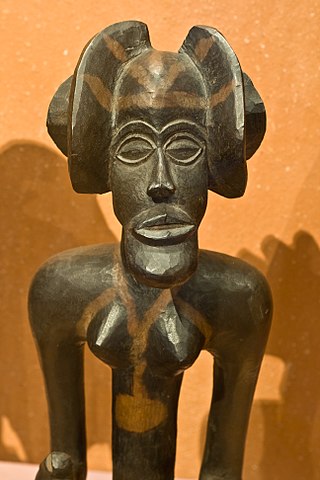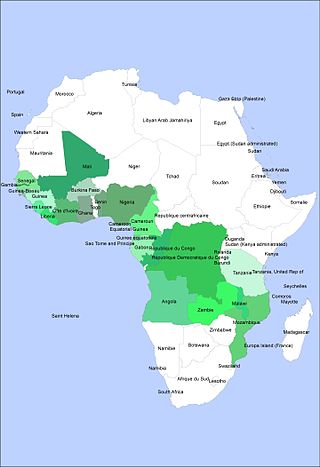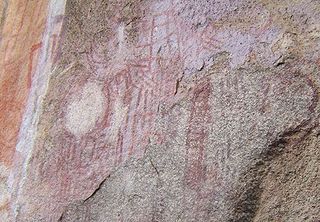
A mask is an object normally worn on the face, typically for protection, disguise, performance, or entertainment, and often employed for rituals and rites. Masks have been used since antiquity for both ceremonial and practical purposes, as well as in the performing arts and for entertainment. They are usually worn on the face, although they may also be positioned for effect elsewhere on the wearer's body.

The Dogon are an ethnic group indigenous to the central plateau region of Mali, in West Africa, south of the Niger bend, near the city of Bandiagara, and in Burkina Faso. The population numbers between 400,000 and 800,000. They speak the Dogon languages, which are considered to constitute an independent branch of the Niger–Congo language family, meaning that they are not closely related to any other languages.

Egungun, in the broadest sense is any Yoruba masquerade or masked, costumed figure. More specifically, it is a Yoruba masquerade for ancestor reverence, or the ancestors themselves as a collective force. Eégún is the reduced form of the word egúngún and has the same meaning. There is a misconception that Egun or Eegun is the singular form, or that it represents the ancestors while egúngún is the masquerade or the plural form. This misconception is common in the Americas by Orisa devotees that do not speak Yorùbá language as a vernacular. Egungun is a visible manifestation of the spirits of departed ancestors who periodically revisit the human community for remembrance, celebration, and blessings.

The Gẹlẹdẹ spectacle of the Yoruba is a public display by colorful masks which combines art and ritual dance to amuse, educate and inspire worship. Gelede celebrates “Mothers”, a group that includes female ancestors and deities as well as the elderly women of the community, and the power and spiritual capacity these women have in society. Focusing not only on fertility and motherhood but also on correct social behavior within the Yoruba society.

The Chokwe people, known by many other names, are a Bantu ethnic group of Central and Southern Africa. They are found primarily in Angola, southwestern parts of the Democratic Republic of the Congo, and northwestern parts of Zambia.

The Chewa are a Bantu ethnic group found in Malawi, Zambia and few in Mozambique. The Chewa are closely related to people in surrounding regions such as the Tumbuka and Nsenga. They are historically also related to the Bemba, with whom they share a similar origin in the Democratic Republic of the Congo. As with the Nsenga and Tumbuka, a small part of Chewa territory came under the influence of the Ngoni, who were of Zulu or Natal/Transvaal origin. An alternative name, often used interchangeably with Chewa, is Nyanja. Their language is called Chichewa. Internationally, the Chewa are mainly known for their masks and their secret societies, called Nyau, as well as their agricultural techniques.
The Dan or Mano-Dan are a Mande ethnic group from northwestern Ivory Coast and neighbouring Liberia. There are approximately 700,000 members of the group and their largest settlement is Man, Ivory Coast. Neighboring peoples include the Krahn, Kpelle and Mano. They are officially known as Yacouba.

Traditional African masks play an important role in ceremonies, rituals, and masquerades across West, Central, and Southern Africa. Ceremonies in which masks are worn include harvest celebrations, funerals, rites of passage, weddings, and coronations. In some societies, masks and masquerades are also used to settle disputes and communal conflicts.

A masquerade ceremony is a cultural or religious event involving the wearing of masks. The practice has been seen throughout history from the prehistoric era to present day. They have a variety of themes. Their meanings can range from anything including life, death, and fertility. In the Dogon religion, the traditional beliefs of the Dogon people of Mali, there are several mask dances, including the Sigi festival. The Sigi entered the Guinness Book of Records as the "Longest religious ceremony".

Chongoni Rock Art Area is located in the Central Region of Malawi consisting of 127 sites in the forested hills of the Malawi plateau with depictions of rock art and paintings of the farmer community of the Late Stone Age and the Iron Age period. This ancient record of the cultural history is in vogue even now.

Igbo art is any piece of visual art originating from the Igbo people. The Igbo produce a wide variety of art including traditional figures, masks, artifacts and textiles, plus works in metals such as bronze. Artworks from the Igbo have been found from as early as 9th century with the bronze artifacts found at Igbo Ukwu. With processes of colonialism and the opening of Nigeria to Western influences, the vocabulary of fine art and art history came to interact with established traditions. Therefore, the term can also refer to contemporary works of art produced in response to global demands and interactions.
The Songye people, sometimes written Songe, are a Bantu ethnic group from the central Democratic Republic of the Congo. They speak the Songe language. They inhabit a vast territory between the Sankuru/Lulibash river in the west and the Lualaba River in the east. Many Songye villages can be found in present-day East Kasai province, parts of Katanga and Kivu Province. The people of Songye are divided into thirty-four conglomerate societies; each society is led by a single chief with a Judiciary Council of elders and nobles (bilolo). Smaller kingdoms east of the Lomami River refer to themselves as Songye, other kingdoms in the west, refer to themselves as Kalebwe, Eki, Ilande, Bala, Chofwe, Sanga and Tempa. As a society, the people of Songye are mainly known as a farming community; they do, however, take part in hunting and trading with other neighboring communities.
The Chamba are a significant ethnic group in the north eastern Nigeria. The Chamba are located between present day Nigeria and Cameroon. The closest Chamba neighbours are the Mumuye, the Jukun and Kutep people. In Cameroon, the successors of Leko and chamba speakers are divided into several states: Bali Nyonga, Bali Kumbat, Bali-Gham, Bali-Gangsin, and Bali-Gashu. They are two ethnic groups in Ghana and Togo also called Chamba, but they are ethnically distinct. The Chamba are identified through their own language, beliefs, culture, and art.
The KungoniCentre of Culture and Art is a non-profit organization in central Malawi. Kungoni is located in Mua, a village in the Dedza district, about 60 km from Salima. Kungoni is both easily accessible, being about two hours drive on bitumen from Lilongwe and three from Blantyre. Kungoni sits a little above the lake plain, with views to the lake in one direction and the African Rift Valley escarpment in the other. The site is landscaped and planted as a botanic garden with a variety of tropical trees and shrubs.
The Hemba people are a Bantu ethnic group in the Democratic Republic of the Congo (DRC).

The Okuyi is a rite of passage practised by several Bantu ethnic groups in different countries mainly across the west coast of Central Africa. Some of the countries where the rite is exercised include Cameroon in West Central Africa, Gabon and Equatorial Guinea. Traditionally, the rite is performed at numerous special occasions including funerals and weddings. Usually when an infant reaches four months of age or when a child becomes an adolescent, an Okuyi ritual is applied as well. Today, the Mekuyo rite is exercised by a range of ethnic peoples within the Bantu cluster. The coastal community known as Ndowe, also known as playeros, is a primary example, as peoples across Equatorial Guinea frequently perform the ritual in public. Gabon has two chief ethnic groups that exercise the Okuyi rite including the Mpongwe and Galwa from Lambaréné, Gabon. The man in the custome is usually the leader of the group.
The Kwele people, or Bakwele, are a tribal group of eastern Gabon, Republic of the Congo, and Cameroons in Central Africa. In terms of their language, they fall into the Bantu linguistic group. Their population consists of approximately 120,000 individuals. They fled the coastal area of West Africa during the 19th century after their traditional enemies acquired firearms from the slave traders. This altercation is often called the "Poupou" war. The Kwele then settled into lands between the Dja and Ivindo rivers. Their assumed five separate linguistic subgroups are identified by differences in where their community lies on a map, where they have migrated over time, political structure, performances implemented in rituals, and the community cohesion within each. When conflicts arise, their strategies to resolve these issues may be handled by intense individual competition. Important relations are impacted by the father's line of descent, due to past patrilineal and avuncular political decisions and relations.

Public masquerades play an extremely significant role in the life of the Mende people - one of the two largest ethnic groups in Sierra Leone.

The art of Burkina Faso is the product of a rich cultural history. In part, this is because so few people from Burkina have become Muslim or Christian. Many of the ancient artistic traditions for which Africa is so well known have been preserved in Burkina Faso because so many people continue to honor the ancestral spirits, and the spirits of nature. In great part they honor the spirits through the use of masks and carved figures. Many of the countries to the north of Burkina Faso had become predominantly Muslim, while many of the countries to the south of Burkina Faso are heavily Christian. In contrast many of the people of Burkina Faso continue to offer prayers and sacrifices to the spirits of nature and to the spirits of their ancestors. The result is that they continue to use the sorts of art that we see in museums in Europe and America.
Jan Mathijs Schoffeleers (1928–2011), who published many of his works in English as Jan Matthew Schoffeleers or Matthew Schoffeleers was a Dutch missionary and member of the Montfort Fathers order who became an important figure in African research as an anthropologist of African religion, particularly that in Malawi, where he spent around 16 years, first as a missionary and then as a lecturer. He continued his academic career later as reader and professor in religious anthropology in the Netherlands, continuing to concentrate on African themes.














